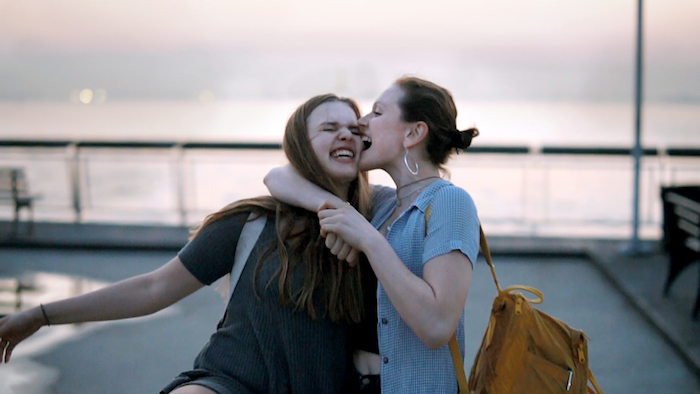Girlhood in Clinton Hill: All This Panic


Directed by Jenny Gage
Opens March 31 at IFC Center
A teenage dream: that someone will follow you around with a movie camera, coaxing out your most sensitive and insightful innermost thoughts, giving your dramas the scope and flair of cinema, for an audience that will eventually marvel at how interesting you are, how simultaneously unique and universal. Now—as relieved as you are that no one actually made a movie of your transition from high school to college, be equally glad that Jenny Gage and Tom Betterton documented three years in the lives of the girls of All This Panic.
Gage and Betterton, photographers, approached the parents of Ginger and Dusty, their neighbors in Clinton Hill, about filming their daughters as they approached adulthood. The core of the film is Ginger, who stays at home post-high school to pursue an acting career but ends up mostly defending her directionlessness against her father’s too-palpable frustration, and Ginger’s close high school friend Lena, who evolves over the course of the film from a gawky debate nerd, self-conscious but passionate as she lisps through her braces, to a long-limbed, green-haired Sarah Lawrence gal holding her own amid her divorced parents’ contentious relationship and precarious financial situations. Ginger and Lena’s waning BFF-ship has an echo in the younger pair Dusty and her friend Delia, who speak mostly theoretically, in dreamy afternoons on rooftops, about the changes to come—who’s going to get a boyfriend first?—and the film radiates outward from there (the connections between the girls are established fleetingly if at all, but they’re not really necessary). Ginger’s friend Ivy embodies the monied grunge of young Brooklyn, snapping selfies at warehouse parties and eating some kind of gross waffle burger thing, like a DIY double-down, at a metal festival—but by film’s end she seems headed toward work, and before her hedonism turns into a rut. Olivia, who spends gray mornings surfing in the Coney Island Channel, reflects straightforwardly about her hesitancy in coming out. Sage, the sole nonwhite protagonist, is self-aware as she considers the intersections of race and class in NYC’s many-tiered education system, and spars in a heartening and high-spirited way with her disciplined, adoring widowed Jamaican mother.
Watching this film, you will feel incredibly protective of these girls—both because they’re young people not quite making eye contact with the camera as they talk through life’s first inflection points, and because they’re so promising, thoughtful and articulate, and at least as savvy and accomplished as you were at that point in your trajectory. The film gives a bracing view of what adolescence is like for city kids with semi-reformed bohemian parents: it means an apartment stocked with champagne for a high-school party, tripping on acid at the Met, generally navigating the city without a second thought—you can see how going away to college could at least seem like a step down in worldliness.
The film begins in the midst of high school, with worry over parties and boys—Lena’s morning-after recap of getting drunk at a party and kissing a boy, but not the right one, is perfect in a teen-movie way—but it doesn’t stay there, and the film is overall more concerned with the girls as philosophical rather than social beings, especially as archetypal kid stuff gives way to the trickier and more individual challenges of becoming a fully autonomous person in the world. The film’s visuals, with intense shallow-focus close-ups, are inevitably compared to the vernacular of Instagram, and while a more concrete sense of the ever-changing Brooklyn backdrop would have made an interesting rhyme with the character development, Gage and Betterton’s style is fittingly present-tense. Milestones—graduation, relationship—pass without being dwelt upon, with changes in appearance and attitude the only markers of where these girls are at, today. (C’mon… keep up.) All This Panic feels very short at 79 minutes, but that’s quite appropriate for a film which takes seriously the way 17-year-olds can feel nostalgia for their youth. In the film’s climactic sequence, Lena is on her way to catch a late-night bus out of Port Authority, a summer of travel across middle America ahead of her. Like at the end of Boyhood, we’ve watched this person grow up to the point where she’s now taking on the world on her own terms, no anchors beyond what she can fit in a suitcase, and as she gifts the filmmakers with a perfect closing speech about the city and the world, the past and the future, we see a montage of the film’s characters from throughout their high school and college and lost years, clips we’ve seen and clips we haven’t, flying by in a blur. Gage and Betterton have said in interviews they shot 130, 140 hours of footage total. I hope they’re hanging onto it—if the young women of All This Panic haven’t asked for the raw footage yet, they’ll want it someday.
You might also like 




















